#kunstkamer
Text
{D-Q Feature}: ‘Kunstkamer - a reflection’

‘Kunstkamer - a reflection’
Ian Bell
21 June 2022
The gestural language of human bodies is fascinating even inspiring[1]. It can intimate moods and all kinds of scenarios and dilemmas. Spacing and pacing as well as artful coordination of speed and athleticism may produce especially notable episodes. This language is omnipresent in all human settings whether households or the arenas of work, consumption, sport, art and more. Crucially, it is expressed (and sometimes overtly formulated) at the boundary of inner subjectivities – conscious and sub-conscious - and externalised identities enacted in social settings.
A professionally, choreographed dance work is one example of an overtly formulated and charged distillation of such a language. In this case, the gestural possibilities are amplified when formal cultures of choreography and story-telling are combined with specific narratives, fashions and costumes, sets, lighting, music and film.
In a recent season of the long work, Kunstkamer, the Australian Ballet (AB) has reworked all these elements. First created by four choreographers of the Netherlands Dance Theatre (NDT) in the period up to late 2019, and ‘steered’ by Paul Lightfoot, it was a work designed to celebrate sixty years of the NDT, and the myriad possibilities of dance[2]. Paul Lightfoot describes it as “a beautiful monster”.
After its opening in 2019 in The Netherlands, a European tour was cut short by the covid-19 pandemic. This adds to the significance of the Australian Ballet’s full staging of the work across multiple, Australian cities in the period April to June 2022.
Kunstkamer means an art room or cabinet of curiosities. Renown in Europe from early modern times as collections of unusual or foreign artifacts, especially those yielded-up by nature and exploration, cabinets of curiosities were the forerunners of museums[3]. Indeed, in some cases they furnished the founding collections for the same. For the NDT, a specific inspiration arose from the C18th works of one, Albertus Bela, especially the latter’s four volume book detailing his collection.
Here the ‘cabinet’ metaphor translates to a series of vignettes rather than an integrated, narrative work. These explore different possibilities of dance and gestural language creating a museum-like experience. The set reinforces this with large, grey, moveable, wall-like structures composed of myriad doors that usher dancers and scenes in and out. The set lighting works precisely to support fluid movement between effects and scenes.
The work, then, eschews narrative apart from micro-stories in vignette but adds singing as well as spoken word with allusive and evocative effects. Each scene is supported by different musical extracts. Some parody particular dance forms in a humorous fashion; for instance, stiff, Strauss waltzes that can sometimes be stifling and class-conscious. Others affirm and take seriously more marginal modes of being: the individual seemingly at the end of their tether or, alternatively, facing a long trek on a road to somewhere unclear.
Most ambitiously, and harking back to Bela’s collections and taxonomies, Kunstkamer begins with, and works from, the premise of a shared capacity for bodily movement and gesture across species; as the AB’s synopsis puts it – across “art and science”. This concern with shared capacity is set from the start via flickering video images.
As one would expect there are strong solo performances as well as pas-de-deux. But what impresses here is the strong, collective structure and organisation as individuals and sub-groups merge into very large ensembles for difficult, extended scenes[4].
Pacing and timing here deserve particular notice; they are radically polarised. The second half, for instance, opens with a stylish and funny, immobile performance supporting posing and day-dreaming. By contrast, most of the scenes feel frenetic, and the shifts between them sometimes “violent”[5]. Overall, I was left entranced but also somewhat exhausted and dizzy by the end.
Nonetheless, as whole, the work is inspiring. The sheer number of forms and the array of music are rarely experienced in one work. At times the nerve-endings around my spine were electrified with the senses firing salvos right through my inner world. Kunstkamer, then, achieves its goal of a celebration of dance and artful movement. It inspires us to continue our own journeys of embodied movement with and for others, and for ourselves.
Copyright: Ian Bell
[1] The writer approaches the issues both from an outsider’s aesthetic love of dance language and music, and the experience of movement as a life-long yoga practitioner.
[2] In addition to Paul Lightfoot, the choreographers included Sol Leon, Crystal Pite and Marco Goecke. Lightfoot discusses the steering process in his interview with David Hallberg, Australian Ballet (2022), ‘A beautiful monster|Hallberg in Conversation with Paul Lightfoot’, 19 April, https://www.youtube.com/watch?v=zdCqIq53BT0, viewed 9 June 2022.
[3] Rooms or cabinets of curiosities had mixed reputations. In some hands they were like trophy cabinets representing the spoils of conquest and colonialism. But in others’ they represented an effort to conserve and document nature, and to promote new, less exploitative attitudes towards it.
[4] Intimations of this difficulty are illustrated by the preparatory videos shared with the public: Australian Ballet (2022), ‘Journey to Opening Night|Kunstkamer’ 21 April. <https://www.youtube.com/watch?v=K0vUt23GLNY&t=80s>, viewed 9 June 2022.
[5] This descriptor is Tim Brynes’ in his 4 June 2022 Guardian Australia review: ‘Kunstkamer review: this fiendishly, complicated ballet is astonishing’, https://www.theguardian.com/stage/2022/jun/05/kunstkamer-review-this-fiendishly-complicated-ballet-is-astonishing, viewed 13 June 2022.

Image: Australian Ballet in ensemble in Kunstkamer, ph David Boud.
#australia#australian ballet#dance#ballet#art#auspol#kunstkamer#cabinet of curiosities#netherlands dance theatre#choreography#paul lightfoot#sol leon#crystal pite#marco goecke#david hallberg#ian bell
9 notes
·
View notes
Text
David Hallberg dances with the Australian Ballet for a live-streamed programme
The Australian Ballet presents Kunstkamer, streaming live on 10 June 2022, with David Hallberg and choreographers León, Lightfoot, Goecke, Pite.
Kunstkamer – The Australian Ballet, Sydney, photo by Daniel Boud
The Australian Ballet presents Kunstkamer, one of the most ambitious contemporary dance productions to appear in the company’s repertoire. It will be streamed live from the Arts Centre in Melbourne and will be available to audiences throughout the world on 10 June 2022. The company’s Artistic Director, David Hallberg, will make a…
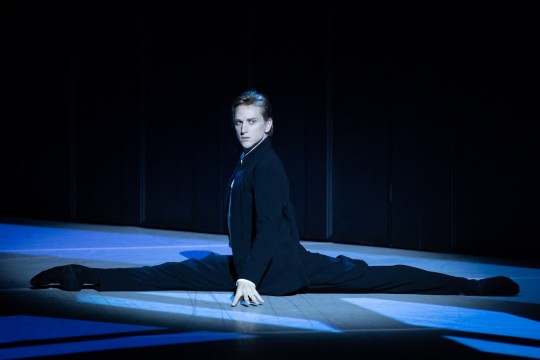
View On WordPress
2 notes
·
View notes
Photo
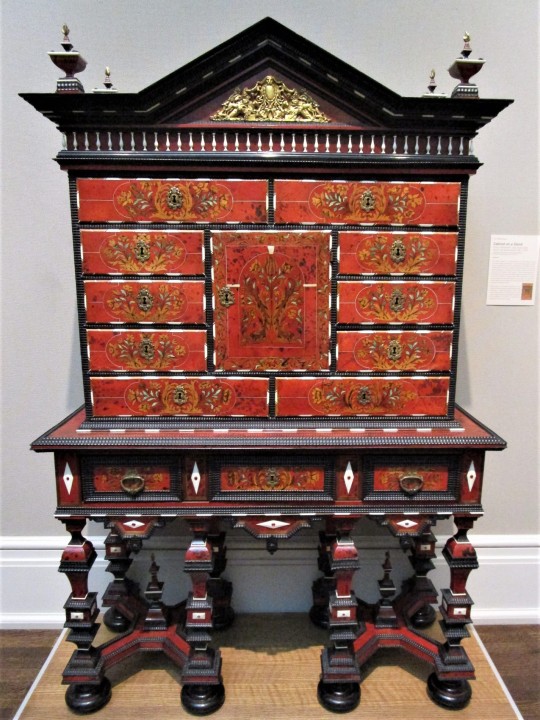
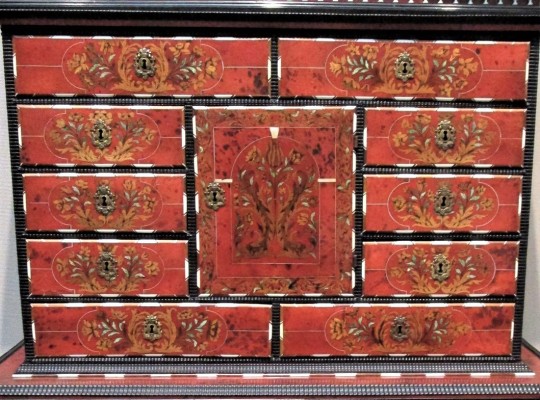
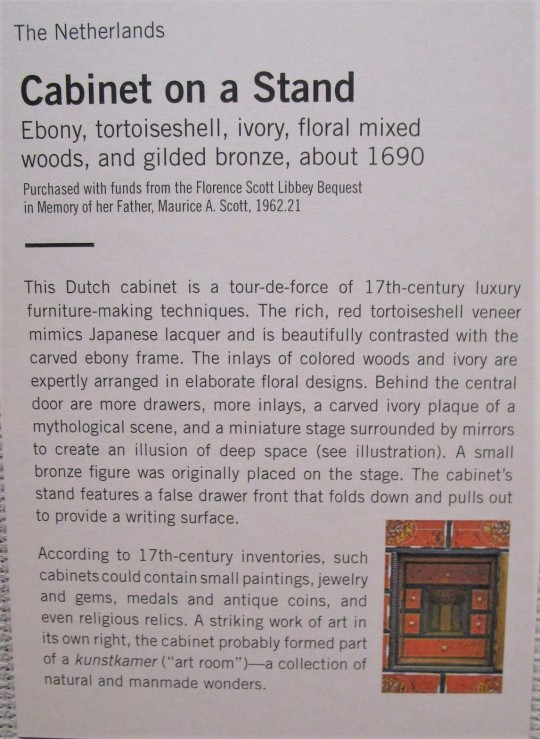
Dutch Cabinet on Stand, ca 1690 - Toledo Museum of Art
#antique furniture#collector's cabinet#marquetry#Netherlands#17th century#decorative arts#kunstkamer#cabinetmaking#woodwork#Toledo#Ohio
17 notes
·
View notes
Photo
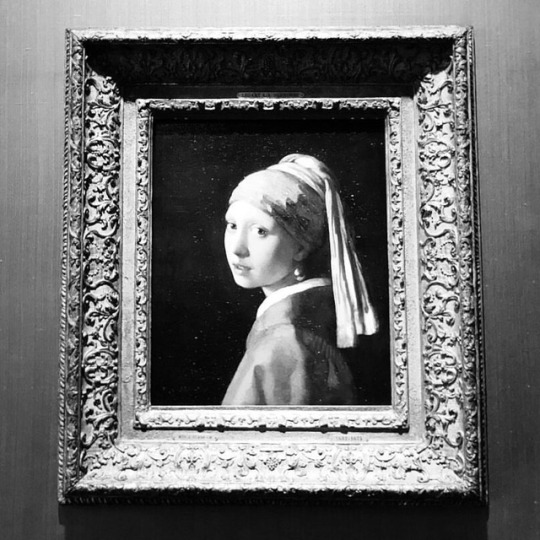
@mauritshuis_museum #flemish #german #italien #kunstkamer #art #choseart #kunst #kunstwerk #janvermeer #girlwiththepearlearring #tronie #masteroflight #theshiningpearl #girlwithapearlearring #softness #girl #choseart #vermeer #blackandwhite #black #carbon #carbonamsterdam (hier: Mauritshuis)
#flemish#german#italien#kunstkamer#art#choseart#kunst#kunstwerk#janvermeer#girlwiththepearlearring#tronie#masteroflight#theshiningpearl#girlwithapearlearring#softness#girl#vermeer#blackandwhite#black#carbon#carbonamsterdam
2 notes
·
View notes
Photo

Apelles Painting Campaspe (Willem van Haecht) #latepost #kunstkamer #artroom #willemvanhaecht #mauritshuis #museum #mauritshuismuseum #17thcentury #painting #oiloncanvas #dutchgoldenage #denhaag #thehague #netherlands (at Mauritshuis) https://www.instagram.com/p/B2d8EzBHCbJ/?igshid=uhvzurgqkjxk
#latepost#kunstkamer#artroom#willemvanhaecht#mauritshuis#museum#mauritshuismuseum#17thcentury#painting#oiloncanvas#dutchgoldenage#denhaag#thehague#netherlands
0 notes
Photo
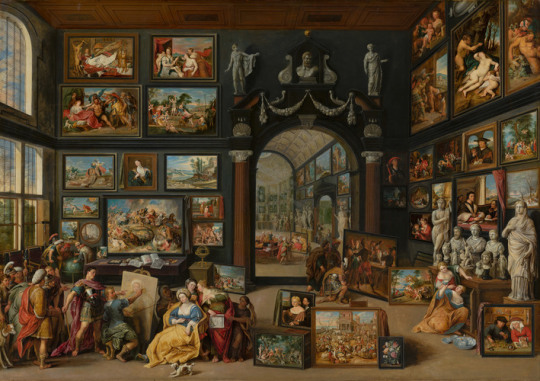
Apelles Painting Campaspe, Willem van Haecht, 1630, Mauritshuis Museum
This room is filled with paintings that are all existing Flemish, German and Italian works of art. The statues, too, are well-known classics. This ‘kunstkamer’, or art room, was painted by Willem van Haecht. It was a popular subject, particularly in Antwerp. In the left foreground, Van Haecht depicted a story from classical antiquity. It shows Apelles painting the portrait of Campaspe, the lover of Alexander the Great. His patron thought the portrait was so beautiful that it could take Campaspe’s place, and he presented his lover to Apelles as a gift. Alexander chose art above nature.
https://www.europeana.eu/portal/record/2021672/resource_document_mauritshuis_266.html?utm_source=api&utm_medium=api&utm_campaign=j4AoMQNzp
13 notes
·
View notes
Text

Gonzales Coques (with many other artists)
Interior with Figures in a Picture Gallery 1670-1675
Pictures showing rooms full of paintings and other works of art are known as gallery paintings (kunstkamers). It was a genre that flourished in seventeenth-century Antwerp. This particular gallery painting is unusual since as many as twenty artists worked on it. Each artist contributed one or more of the miniature paintings, co-ordinated by Gonzales Coques, who also painted the figures in the foreground. For a contemporary viewer of a group work like this, it would have been great fun to see who could recognise the most masters.
Stadholder William IV purchased this work at an auction in 1741 and it was installed in Het Loo Palace. His son William V later brought the painting to The Hague, where it hung in his Gallery.
Mauritshuis
8 notes
·
View notes
Photo
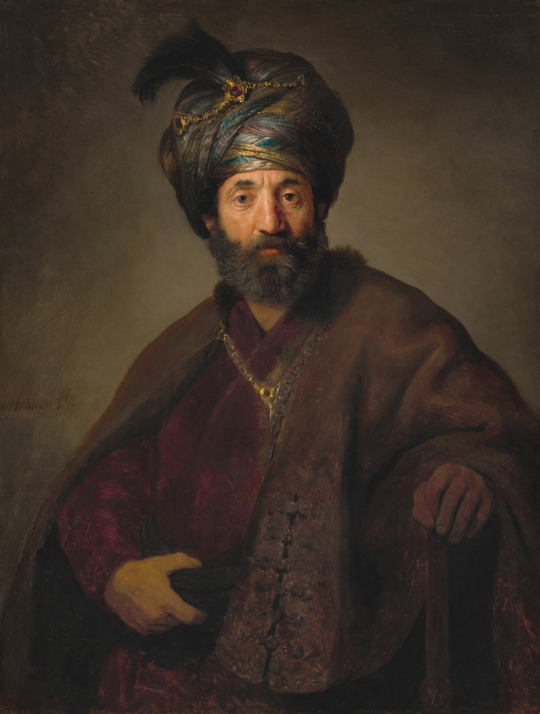
Man in Oriental Costume | Rembrandt Van Rijn And Workshop (Probably Govaert Flinck) | 1635 | National Gallery of Arts, Washington
“After learning the fundamentals of drawing and painting in his native Leiden, Rembrandt van Rijn went to Amsterdam in 1624 to study for six months with Pieter Lastman (1583–1633), a famous history painter. Upon completion of his training Rembrandt returned to Leiden. Around 1632 he moved to Amsterdam, quickly establishing himself as the town’s leading artist, specializing in history paintings and portraiture. He received many commissions and attracted a number of students who came to learn his method of painting. In this imposing half-length image, a bearded man wearing an elaborate, bejeweled turban stares out at the viewer, his features strongly modeled by light streaming in from the left. A fur-lined cape, loosely clasped at the neck with a gold chain, covers his shoulders. His right hand grasps the sash that wraps around his waist, while his other hand rests on a wooden staff. An aigrette, a type of pin with a tuft of ornamental bird feathers that was a standard part of Ottoman attire, secures a heavy gold chain on the man’s turban. Rembrandt, as a history painter, was particularly intrigued by the Middle East, where so many of the Biblical stories he frequently depicted had taken place. Rembrandt’s paintings, drawings, and etchings of the 1630s included numerous figures who wear Middle-Eastern garb. By the early seventeenth century the commercial enterprises of Dutch merchants had reached the Middle East, so exotically dressed foreigners were a familiar sight in the streets and marketplaces of Amsterdam. Exotic attire became a fashion fad, and Dutch men, including Rembrandt himself, would sometimes be portrayed wearing similar outfits. At the same time, Dutch collectors avidly sought to acquire exotica from all parts of the world, including shells, swords, musical instruments, and costumes, which they would then display for visitors to admire. Rembrandt owned such a collection, known as a kunstkamer, or cabinet of curiosities. His encyclopedic holdings of art and artifacts served as props for Rembrandt and his students, but the artist was also motivated to amass such a collection by his desire to be recognized as a full-fledged member of the class of gentlemen-collectors.”
#man in oriental costume#Rembrandt van Rijn#govaert flinck#dutch#The Netherlands#golden age#National Gallery of Arts Washington
50 notes
·
View notes
Photo
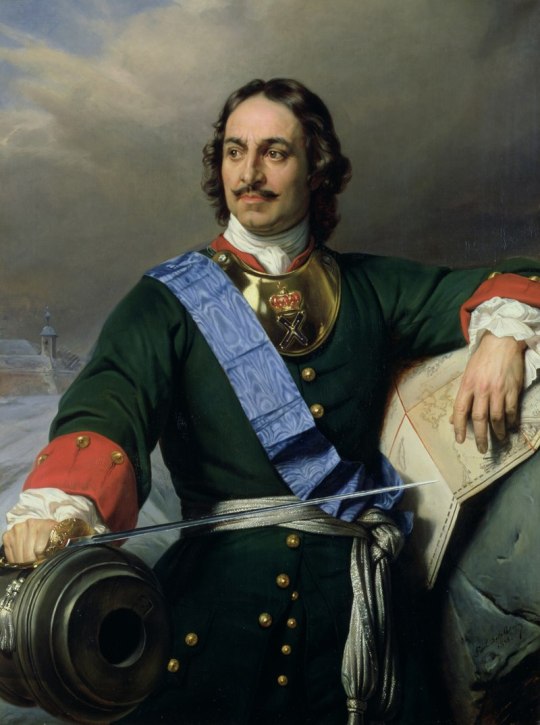
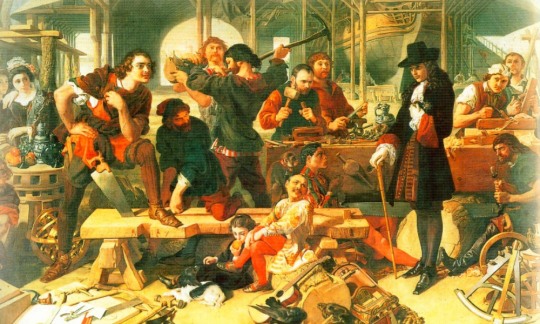
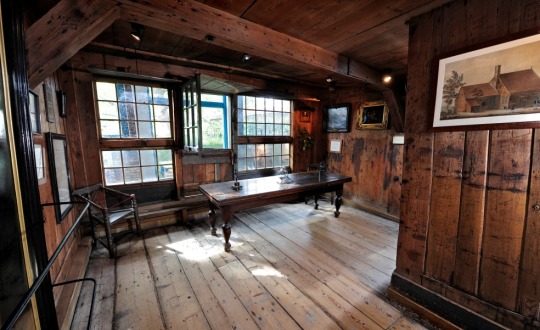

Peter de Grote
Peter I, ook wel de Grote genoemd vanwege zijn daden en zijn lengte van ongeveer 2 meter, was de tsaar van Rusland tussen 1682 en 1725. Peter is vooral bekend geworden omdat hij Rusland heeft gemoderniseerd en veranderd tot in een wereldrijk. Om dit voor elkaar te krijgen, zocht Peter naar hulp en kennis uit West-Europa. Dit deed hij door incognito af te reizen naar landen zoals Oostenrijk, Engeland, Pruisen en de republiek der Nederlanden. Zijn bezoek aan Nederland is zeker een interessant verhaal wat de start was van een Nederlands/Russisch vriendschap die nu al 400 jaar oud is. Dit is uitgebreid gevierd in 2013, ik ben zelf op bezoek geweest bij een Russisch marineschip in dat jaar.
Op 18 augustus 1697 kwam Peter de Grote, incognito, aan in Nederland. Hij vond onderdak bij een boer op de scheepswerf in Zaandam. Peter wilde graag dat de boer zijn ware identiteit geheim hield maar helaas was de vrouw van de boer een roddelaarster die overal rondbazuinde dat de tsaar van Rusland in hun huis aanwezig was. Dit leidde al snel dat Peter overal werd gevolgd door een groot nieuwsgierige menigte die graag een glimp wilde opvangen van zo'n hoog bezoek.
Een weekje later vertrok Peter de Grote naar Amsterdam. De burgemeester van Amsterdam, Nicolaas Witsen, onthaalde Peter enthousiast en regelde een geschikte plek voor Peter om te wonen en te werken. Ongelooflijk genoeg voor een machtige Russische tsaar, kreeg hij een baantje als scheepstimmerman in de haven van Amsterdam.
Elke dag begon hij om 6 uur 's ochtends te werken op de scheepswerf. Rond het middaguur nam hij zijn dagelijkse wodka, naar Russisch traditie, en deed zijn staatszaken in de middag. Peter de Grote vond het niet erg om zijn keizerlijke etiquette aan de kant te schuiven, hij ontving zijn gasten gewoon op de werkvloer. Tijdens de avond probeerde Peter zich ook te verdiepen in de Nederlandse literatuur en taal.
Peter verbleef 4 maanden in Amsterdam. Tijdens zijn verblijf leerde hij de Nederlandse taal, bezocht hij hospitalen, tuinen, kledingateliers en drukkerijen. Hij bleek erg veel respect te hebben voor Nederland. Peter had zelfs plannen om de Nederlandse taal in te voeren als zijn hoftaal en hij heeft de Nederlandse vlag overgenomen wat nu nog steeds de huidige Russisch vlag is.
Wat deed Peter de Grote nou eigenlijk precies in Nederland? Peter was een groot liefhebber van schepen en de kunst van het zeilen. Hij wilde de Russische vloot moderniseren door kennis te gebruiken van het land met de beste kundigheid in scheepsbouw, dit was dus de reden waarom Peter naar Nederland toe reisde om vervolgens als een timmerman aan de slag te gaan op een scheepswerf.
Niet alleen heeft dit bezoek ervoor gezorgd dat de Russen nu een variatie van de Nederlandse vlag gebruiken, Peter bracht ook meer dan duizend Nederlandse woorden terug die uiteindelijk in de Russische taal terecht zijn gekomen. Hier zijn een paar voorbeelden: Matroos - matros, Koers - kóers, kombuis - kambuz, storm - sjtorm, broek - brjóekie, anker - ánker, Averij - avária, voor de tocht - Fortotskja, ruim - rióem. Peter de Grote was tijdens zijn leven ook een aardige feestbeest, dit maakte blijkbaar een grote indruk op de Hollanders aangezien het Russische woord voor feest, píer, is blijven hangen in Nederland en is verbasterd naar het woord Pierewaaien.
Tussen 1716-1717 bezocht Peter Nederland nog een keer incognito. Hij verbleef samen met zijn vrouw in Amsterdam bij Christoffel van Brants, een koopman. Hij bezocht steden zoals Leiden, Den Haag, Zijdebalen en Maastricht. Tijdens zijn tweede verblijf kocht hij kunstwerken in en wetenschappelijke objecten zoals twee kwikthermometers.
Peter nodigde de Leidse professor, Willem Jacob's Gravesande, uit om naar Rusland te reizen en zijn academie van wetenschappen te bezoeken. De meeste van Peter's collectie aangeschafte objecten belandde in de kunstkamer in Sint-Petersburg wat uiteindelijk de eerste museum voor natuurwetenschappen van Rusland werd.
Zijn bezoek aan Nederland was belangrijk en had grote gevolgen voor de toekomst van Rusland. Mede dankzij de Nederlandse kennis van scheepsbouw, maakte Peter van Rusland een machtig keizerrijk en bracht hij de gemoderniseerde West-Europese cultuur naar Rusland. Dankzij dit bezoek bevat de Russische taal veel Nederlandse woorden, zijn Nederland en Rusland goed bevriend en is de Russische vlag wit-blauw-rood, gebaseerd op onze Hollandse rood-wit-blauw.
Hier zijn afbeeldingen van:
Peter aan de slag op een scheepswerf in Zaandam door een onbekende artiest,
Portret Peter de Grote door Paul Delaroche,
Peter de Grote op weg naar het schip 'Pieter en Paul' op het IJ in 1698,
Het huisje waar Peter verbleef in Zaandam,
4 notes
·
View notes
Text
Benois de la Danse 2020 nominations
CHOREOGRAPHERS
MARCO GOECKE – Kunstkamer, Johann Strauss. Netherlands Dance Theatre.
ANDREY KAYDANOVSKY – Cecil Hotel, different composers. Bavarian State Ballet.
WAYNE MCGREGOR – Inferno – The Dante Project, Thomas Adès. Royal Ballet London. (YAY!)
CRYSTAL PITE – Body and Soul, Owen Belton, Frederic Chopin, Teddy Geiger. Paris Opera Ballet. (YAY vol.2)
YURY POSSOKHOV – Anna Karenina, Ilya Demutsky. Joffrey Ballet.
ZHAO MING – Bright Red Star, DU Ming. Shanghai Ballet.
BALLERINAS
AMANDINE ALBISSON – The Title role, Carmen, G.Biset-R.Schedrine/M.Ek. Paris Opera Ballet.
VICTORIA JAIANI – The Title role, Anna Karenina, I.Demutsky/Y.Possokhov. Joffrey Ballet.
EKATERINA KRYSANOVA – The Title role, Giselle, A.Adam/J.Coralli, J.Perrot, M.Petipa, A.Ratmansky’s version. Bolshoi Theatre
SARAH LAMB – Cristaux, F.Moon/A.Pita. Joyce Theatre, New York.
SARA MEARNS – A Night of 100 Solos, tribute to Merce Cunningham, different composers/M.Cunningham. Brooklyn Academy of Music,New York
FAN XIAOFENG – Mother of PAN Dongzi, Bright Red Star, DU Ming/ZHAO Ming. Shanghai Ballet.
ANNE JUNG – Carnegie Solo, K.Jarrett/S.Young-Wright. Frankfurt LAB.
DANCERS
JESUS CARMONA – The Game, Riqueni/J.Carmona. Latitude Festival, London.
PAUL MARQUE – Prince Siegfried, Swan Lake, P.Tchaikovsky/R.Nureev. Paris Opera Ballet.
JON VALLEJO – Don Jose, Carmen, G.Biset-R.Schedrin, M.Álvarez/J.Inger. Semper Opera Ballet.
ALBERTO VELAZQUEZ – Alexey Vronsky, Anna Karenina, I.Demutsky/Y.Possokhov. Joffrey Ballet.
WU HUSHENG – PAN Dongzi, Bright Red Star, DU Ming/ZHAO Ming. Shanghai Ballet.
COMPOSER
THOMAS ADÈS – Inferno – The Dante Project, choreographer Wayne McGregor. Royal Ballet London.
DESIGNER
TACITA DEAN — Inferno – The Dante Project, choreographer Wayne McGregor. Royal Ballet London.
6 notes
·
View notes
Photo
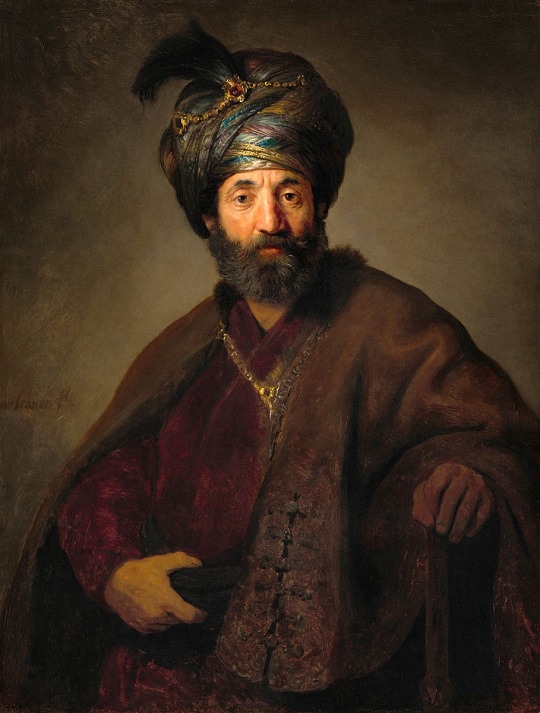
Hombre en traje oriental, do. 1635, de Rembrandt Harmenszoon van Rijn (Leiden, 15 de julio de 1606 - Ámsterdam, 4 de octubre de 1669), y taller, probablemente Govaert Flinck (Holandés, 1615-1660). Óleo sobre lino, en general: 98.5 × 74.5 cm, enmarcado: 128.91 × 104.78 × 9.53 cm. Colección Andrew W. Mellon, National Gallery of Art.
VISIÓN GENERAL
Después de aprender los fundamentos del dibujo y la pintura en su Leiden natal, Rembrandt van Rijn fue a Amsterdam en 1624 para estudiar durante seis meses con Pieter Lastman (1583-1633), un famoso pintor de historia. Al finalizar su entrenamiento, Rembrandt regresó a Leiden. Alrededor de 1632 se mudó a Amsterdam, estableciéndose rápidamente como el artista líder de la ciudad, especializándose en pinturas de historia y retratos. Recibió muchas comisiones y atrajo a varios estudiantes que vinieron a aprender su método de pintura.
En esta imponente imagen de medio cuerpo, un hombre barbudo que lleva un turbante elaborado y adornado mira al espectador, sus rasgos fuertemente modelados por la luz que fluye desde la izquierda. Una capa forrada de piel, ligeramente apretada en el cuello con una cadena de oro, cubre sus hombros. Su mano derecha agarra la faja que se envuelve alrededor de su cintura, mientras que su otra mano descansa sobre un bastón de madera. Una aigrette, un tipo de alfiler con un mechón de plumas ornamentales de aves que era una parte estándar de la vestimenta otomana, asegura una pesada cadena de oro en el turbante del hombre.
Rembrandt, como pintor de historia, estaba particularmente intrigado por el Medio Oriente, donde habían tenido lugar muchas de las historias bíblicas que describía con frecuencia. Las pinturas, dibujos y grabados de Rembrandt de la década de 1630 incluyeron numerosas figuras que vestían atuendos de Oriente Medio. A principios del siglo XVII, las empresas comerciales de los comerciantes holandeses habían llegado a Oriente Medio, por lo que los extranjeros vestidos exóticamente eran un espectáculo familiar en las calles y mercados de Amsterdam. La vestimenta exótica se convirtió en una moda pasajera, y los hombres holandeses, incluido el propio Rembrandt, a veces se representaban con atuendos similares. Al mismo tiempo, los coleccionistas holandeses buscaron con avidez adquirir exótica de todas partes del mundo, incluyendo conchas, espadas, instrumentos musicales y disfraces, que luego exhibirían para que los visitantes los admiraran. Rembrandt poseía tal colección, conocida como kunstkamer, o gabinete de curiosidades. Sus posesiones enciclopédicas de arte y artefactos sirvieron como accesorios para Rembrandt y sus estudiantes, pero el artista también estaba motivado para acumular tal colección por su deseo de ser reconocido como un miembro de pleno derecho de la clase de caballeros-coleccionistas.
Información del museo.
4 notes
·
View notes
Text
We’ve been introduced to Amsterdam in the 17th century. Let’s continue our journey by taking on the Dutch view of the world. The Dutch were keen on categorization: An assured, enterprising curiosity led to great advances in lens-cutting, medicine, navigation and cartography…
Domenico Remps, Cabinet of Curiosities, 1690s
The entire universe could be boiled down to a single ‘kunstkamer’ or ‘cabinet of curiosity’ (often found in a gentleman’s study) – The kunstkamer was encyclopedic, connoisseurs would collect natural, scientific and artificial specimens to line the shelves of specially built cabinets, sometimes, even rooms. These objects would be handled and examined at range… We’re talking collation on a ‘universal scale’ reduced to things you could hold: shells, fish bones, coral, precious stones. There was a drive to bring the universe down to a human scale in this decided ‘Age of Observation’.
Jan Steen, Card Players in an Interior, ca. 1660.
Interestingly though, the broadening of the world’s horizons did not stop the world of the Dutch from retreating into the interior – as, parallel to advancement, the ‘cult of domesticity’ thrived. The ‘bourgeois way of life’ depended on the careful balance of both a private and public front.
Jan Steen, Fantasy Interior with Jan Steen and the Family of Gerrit Schouten, 1659-1660.
Let’s turn to Jan Steen’s Fantasy Interior with Jan Steen and the Family of Gerrit Schouten, a painting which I have chosen for its depiction of aspirations at work. It shows a lavish arrangement of furnishings and the family in question are deliberately set amongst them. This particular painting poses important questions regarding appearances and reality. Essentially, this family portrait was commissioned to broadly advertise the families wealth through the accumulated objects and staging of the scene.
Frontispiece, taken from a London edition of Baldassarre Castiglione’s ‘The Book of the Courtier’ (1561), first printed in Italy, 1528.
Steen achieves this through a display of accomplishments. If we were reading this painting as a code, the code becomes pretty clear: You can read a fashionable Italianate influence from the marbles and sculptural groups which the family are interacting with… The eye is drawn by the glint of a silver service (expensive), the rich hues of luxuriously carved furnishings and we are reminded of the ‘virtuoso’, the ‘maestro’, by the musical instruments. The children are dressed fashionably, their clothes more luxurious than their parents to highlight the new possibilities and opportunities for the younger generation reaped from wealth. Trade and wealth equaled silks and lace. Austerity had become ‘old-fashioned’.
Reynier de la Haye, The Hague, circa 1640 – after 1695, ‘Portrait of a Young Woman Playing the Lute’, Indistinctly signed lower right and dated: 1674.
What we also see here is a father overseeing the accomplishments of his daughters – their education in refinement. Look, he’s saying, they can read and play instruments! Isn’t this domestic bliss! Every element of this painting has been staged for the purposes of display. Family life has been beautifully embellished to denote social ideals.
Gerrit Dou, The Young Mother, between 1655 and 1660 via Wikipedia Commons, Public Domain.
In Gerrit Dou’s Young Mother, a woman sits well within her sphere, the domestic sphere, her home. The Dutch 17th century home was seen as a sacred entity, here, birthing, feasting, entertaining [Roberts]… All the rituals of human life occurred. Dou shows us that, in the home, a woman was central: Within it, she has her tasks, her obligations and her limitations. These were all set out for her and they belonged exclusively to the home. Rather cleverly, this painting has an entirely didactic function, much like that of Jan Steens’: Fantasy Interior is concerned with ‘self-bettering’ whilst Young Mother reads as a textbook with a very clear picture – “this is the conventional framework for the running of a home”.
What was going on behind closed doors? Let’s take a look at De Hooch’s Family Portrait in an Opulent Interior (1663), Card Players in an Opulent Interior (c. 1663 – 1665) and Jacott-Hoppesack Family (1670). These read as a succession of wealthy burgher families, formal, well-attired and leaning towards a stylish classicism in their bearing. De Hooch sees the commercial opportunity of appealing to the rich and by highlighting their social rituals, the contrived luxury of their homes and what it meant, at that time, to be fashionable. To be elegant was considered modern, something learnt from foppish, courtly manuals on manners and ‘good taste’.
To start from the beginning, please follow the link to Part 1/3 of this written web series
Fancy a change of scenery? Get swept away to the world of Versailles
Sources Used:
Abraham-Van der Mark, Eva, Successful Home Birth and Midwifery: The Dutch Model (Het Spinhuis, 1996).
Koeppe, Wolfram, ‘Collecting for the Kunstkammer’, The Met Museum: Heilbrunn Timeline of Art History, October 2002. http://www.metmuseum.org/toah/hd/kuns/hd_kuns.htm [accessed 06 September 2016].
Liedtke, Walter A., ‘Landscape Painting in the Netherlands’, The Met Museum: Heilbrunn Timeline of Art, December 2014. http://www.metmuseum.org/toah/hd/lpnd/hd_lpnd.htm ]accessed 06 September 2016].
Roberts, Benjamin, Through the Keyhole: Dutch Child-rearing Practises in the 17th and 18th Century (Uitgeverij Verloren, 1998).
Smith, Roberta, ‘Art; Exotic Accumulations in Miniature Spaces’, The New York Times, 05 July 1998. http://www.nytimes.com/1998/07/05/arts/art-exotic-accumulations-in-miniature-spaces.html? _r=0 [accessed 05 September 2016].
Worlds Within Worlds Part 1: Dutch Preoccupations in the 17th Century We've been introduced to Amsterdam in the 17th century. Let's continue our journey by taking on the Dutch view of the world.
#accomplishments#age of observation#aspirations#bourgeois#cabinet of curiosities#classicism#decorative arts#domesticity#kunstkamer#luxury#manners#opulent interiors#separate spheres#social ideals#tastes
0 notes
Text
Giveaway – free tickets for Australian Ballet live stream with David Hallberg
Australian Ballet and Gramilano are offering passes to watch the live streaming of the dance work 'Kunstkamer' with David Hallberg on 10 June.
Kunstkamer – The Australian Ballet, Sydney, photo by Daniel Boud
The Australian Ballet and Gramilano are offering passes for five households to watch the live streaming of the dance work Kunstkamer, which features a comeback appearance by the company’s new artistic director David Hallberg. It is one of the most ambitious contemporary dance productions to appear in the company’s repertoire.
The…

View On WordPress
0 notes
Note
Mooi zo!! Wat doe je zo in 't dagelijks leven?
Mijn zus is net uit huis, dus ik ben haar kamer tot kunstkamer aan het maken en mijn eigen kamer aan het herinrichten, dus de afgelopen maand is daar best wat tijd naartoe gegaan. En daarbuiten geef ik 1x week kunstworkshops aan kindjes en ga ik af en toe een dag bij een kinderdagverblijf werken. En dan af en toe wat therapie! Op één of andere manier zijn mijn dagen altijd goed gevuld :-)
1 note
·
View note
Photo
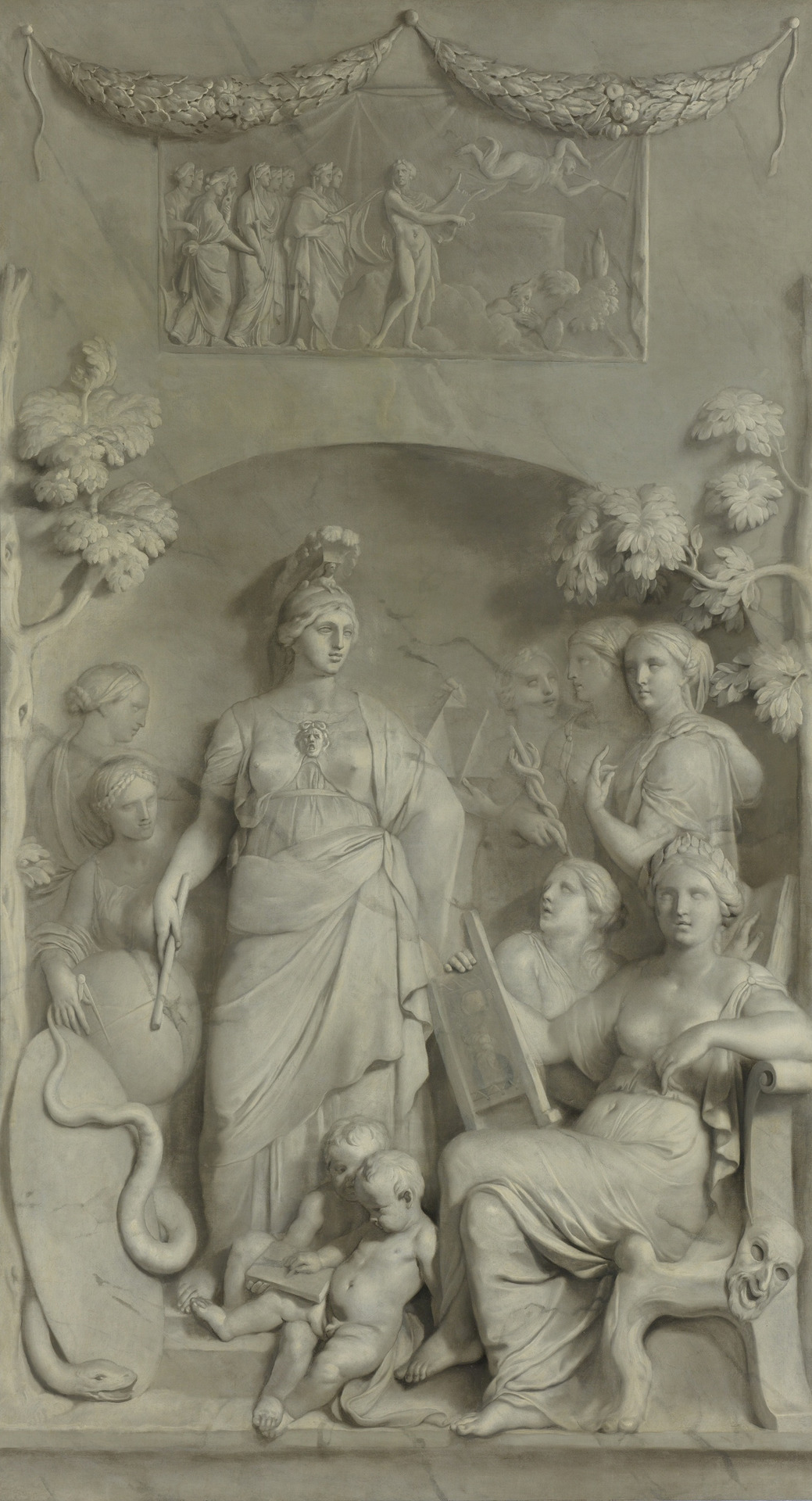
Allegory of the Sciences by Gerard de Lairesse, Museum of the Netherlands
Textielmagnaat Philips de Flines was een ware kunstliefhebber. Zijn pand aan de Herengracht richtte hij in met een speciale kunstkamer, die hij liet decoreren door Gerard de Lairesse. De kunstenaar vervaardigde vijf schilderijen in zwart en wit - ‘grisailles’ - met verbeeldingen van positieve eigenschappen van De Flines. Het bevorderen van de wetenschappen was bijvoorbeeld een van de goede eigenschappen van een edelman.
16 notes
·
View notes
Text
Resultaten inputbriefjes:
2C
In de les doen:
Praten
Films kijken
Kijken naar hoe je iets moet tekenen
Iets inkleuren met kleurpotloden
Op telefoon zitten
Gitaar spelen
Verven/schilderen
Muziek luisteren (tijdens het werken)
Naar museum gaan
Op hout tekenen en verven
Slapen
Dingen ontwerpen
Graffiti (buiten)
Robot maken
Je naam in verschillende letters tekenen
10 min pauze
Vaak over interessante dingen praten
Mensen tekenen
Buiten stoepkrijten
Spelletjes
Over cultuur van Nederland praten
Dingen maken van papier mache
Naar buiten gaan
Dit maakt de les leuker:
Gezellige lessen
Goede samenwerking
Vrijheid maar niet te veel
Plezier
Dat we doen wat we willen doen
2B
In de les doen:
Met muziek aan werken
3d tekenen
Spelletjes
Op telefoon
Dingen maken van hout en dan er op verven
Naar een museum
Naar de bioscoop
Naar buiten gaan (en patat eten)
Meer met schilderen doen
Werken met klei
Snacks eten
Tekenen
Dit maakt de les leuker:
Allerlei schilderijen die zijn gemaakt in lessen in een kunstkamer ophangen of andere dingen die zijn gemaakt in een les in die kamer zetten (een presentatieruimte)
Een keer geen les, filmpjes kijken tijdens de les
Whiteboard op tafel
2D
In de les doen:
Spelletjes
Tekenen
Schilderen/verven
Muziek luisteren
Naar buiten gaan en met graffiti werken
Meer spelletjes over Kunst & Cultuur
Groepsprojecten
Over andere culturen leren
Meer samenwerken met klasgenoten
Naar een museum
In een groep kunst maken
Soms samen eten of drinken
Dit maakt de les leuker:
Liedjes
De les kan niet leuker
Meer met verf en schilderijen doen
Muziek
Gewoon leuke dingen doen
Spelletjes doen en een leuk, mooi lokaal
Wordt het meeste gezegd (alle klassen):
Muziek luisteren (stipt op nummer 1)
Schilderen
Naar buiten gaan
Met graffiti werken
Spelletjes doen
Samenwerken
Naar museum gaan
Observaties/conclusie inputbriefjes:
De inputbriefjes heb ik ingezet bij 3 klassen, twee basis/kader klassen en één mavo klas. De meeste leerlingen reageerden erg positief op het feit dat zij inspraak mochten geven in de lessen, deze leerlingen namen dan ook echt de tijd om het briefje in te vullen maar er waren ook zeker leerlingen die er niks om gaven en “weet ik niet” of “uitval geven” opschreven. Dat hoort een beetje bij deze doelgroep lijkt me, pubers die geen zin hebben om moeite te doen voor een vak wat ze toch niet leuk vinden. Ik ben benieuwd naar hoe zij het zouden vinden als een idee van hun wordt uitgewerkt, ik wil kijken of ik “nutteloze” antwoorden toch kan verwerken in mijn project. Wellicht kan ik hier een artistieke draai aangeven, zo wordt het zinvol voor de lessen K&C en de leerlingen voelen zich in dit geval toch gezien. Hopelijk zal dat voor meer motivatie zorgen in het vervolg. Sommige leerlingen hebben namelijk ook “slapen” opgeschreven, ik kan dit vertalen naar een kunstzinnige opdracht waarbij je bijvoorbeeld een kunstdutje doet, hoe deze opdracht er verder uitziet weet ik nog niet maar daar zou ik over na kunnen denken. Er is veel mogelijk en ik merk dat deze leerlingen dat nog niet inzien, de meeste denken best wel in hokjes, er zijn niet veel “out of the box” ideeën gegeven. Dit geeft ook niet maar het toont wel aan dat pubers niet zo veel durven op artistiek vlak, als je jonge kinderen dezelfde vragen had gesteld had je gok ik veel uiteenloperende antwoorden gehad. Mijn rol als kunstdocent in dit onderzoek is om de ideeën van deze leerlingen of letterlijk te gebruiken of een artistieke draai te geven waardoor er echt een samenwerking tussen mij en de leerlingen ontstaat. Ik probeer dat te bewerkstelligen, een samenwerking tussen mij en de leerlingen zodat het hele lineaire idee van de alwetende docent en ondergeschikte leerlingen een beetje doorbroken wordt. Ik merk dat de leerlingen hier nog aan moeten wennen, het lijkt nieuw voor ze te zijn dat ze zo mee mogen denken op school. Ik hoop door hun ideeën te gebruiken en verwerken voor enthousiasme te zorgen, en een stukje persoonlijke aandacht. Dat de leerlingen zich op deze manier gezien en gehoord voelen. Ik hoop dat dat vervolgens weer voor meer motivatie in het vak K&C zorgt, wat zich uit in de resultaten en werkhouding van de scholieren.
0 notes